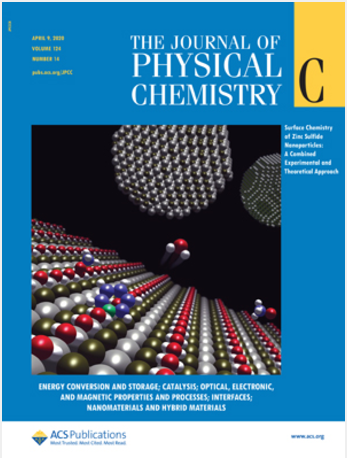Host–Guest Interactions in the C59N•⊂[10]CPP Supramolecular Radical
IF 3.3
3区 化学
Q2 CHEMISTRY, PHYSICAL
引用次数: 0
Abstract
A remarkable stability of a supramolecular radical comprising an azafullerene (C59N•) radical sterically protected by a [10]cycloparaphenylene ([10]CPP) nanoring, C59N•⊂[10]CPP, has recently been observed by various experimental probes. In order to investigate the host–guest interaction in these supramolecular complexes, we carried out electron paramagnetic resonance (EPR) measurements, theoretically supported by density functional theory (DFT) calculations. The continuous wave (CW) EPR spectrum shows the presence of two active spin components: C59N•⊂[10]CPP monomers that can in certain cases polymerize into oligomeric radicals. Two- and three-pulse electron spin echo envelope modulation (ESEEM) measurements allow for determination of experimental hyperfine coupling constants for 13C and 1H atoms and also show the strong coupling to the 14N atom adjacent to the radical C of the azafullerene. These experimental hyperfine coupling constants reasonably agree with those calculated for the DFT optimized supramolecular structures. The results are consistent with a small spin delocalization from the guest (C59N•) to the host ([10]CPP), thereby explaining weak but non-negligible interaction between them. Our study demonstrates that ESEEM experiments in alliance with DFT computations can offer valuable insights into the radical host–guest structures.

C59N•[10]CPP超分子自由基中的主客体相互作用
由氮杂烯(C59N•)自由基组成的超分子自由基(C59N•)被[10]环对苯([10]CPP)纳米环立体保护,C59N•∧[10]CPP)具有显著的稳定性,最近被各种实验探针观察到。为了研究这些超分子配合物中的主客体相互作用,我们进行了电子顺磁共振(EPR)测量,并在理论上得到密度泛函理论(DFT)计算的支持。连续波(CW) EPR谱显示了两种活性自旋组分的存在:C59N•∧[10]CPP单体,在某些情况下可以聚合成低聚自由基。两脉冲和三脉冲电子自旋回波包络调制(ESEEM)测量允许测定13C和1H原子的实验超精细耦合常数,并且还显示了与氮杂烯自由基C附近的14N原子的强耦合。实验所得的超细耦合常数与DFT优化后的超分子结构计算值基本一致。结果与从客体(C59N•)到宿主([10]CPP)的小自旋离域一致,从而解释了它们之间微弱但不可忽略的相互作用。我们的研究表明,ESEEM实验与DFT计算相结合可以为自由基主客体结构提供有价值的见解。
本文章由计算机程序翻译,如有差异,请以英文原文为准。
求助全文
约1分钟内获得全文
求助全文
来源期刊

The Journal of Physical Chemistry C
化学-材料科学:综合
CiteScore
6.50
自引率
8.10%
发文量
2047
审稿时长
1.8 months
期刊介绍:
The Journal of Physical Chemistry A/B/C is devoted to reporting new and original experimental and theoretical basic research of interest to physical chemists, biophysical chemists, and chemical physicists.
 求助内容:
求助内容: 应助结果提醒方式:
应助结果提醒方式:


